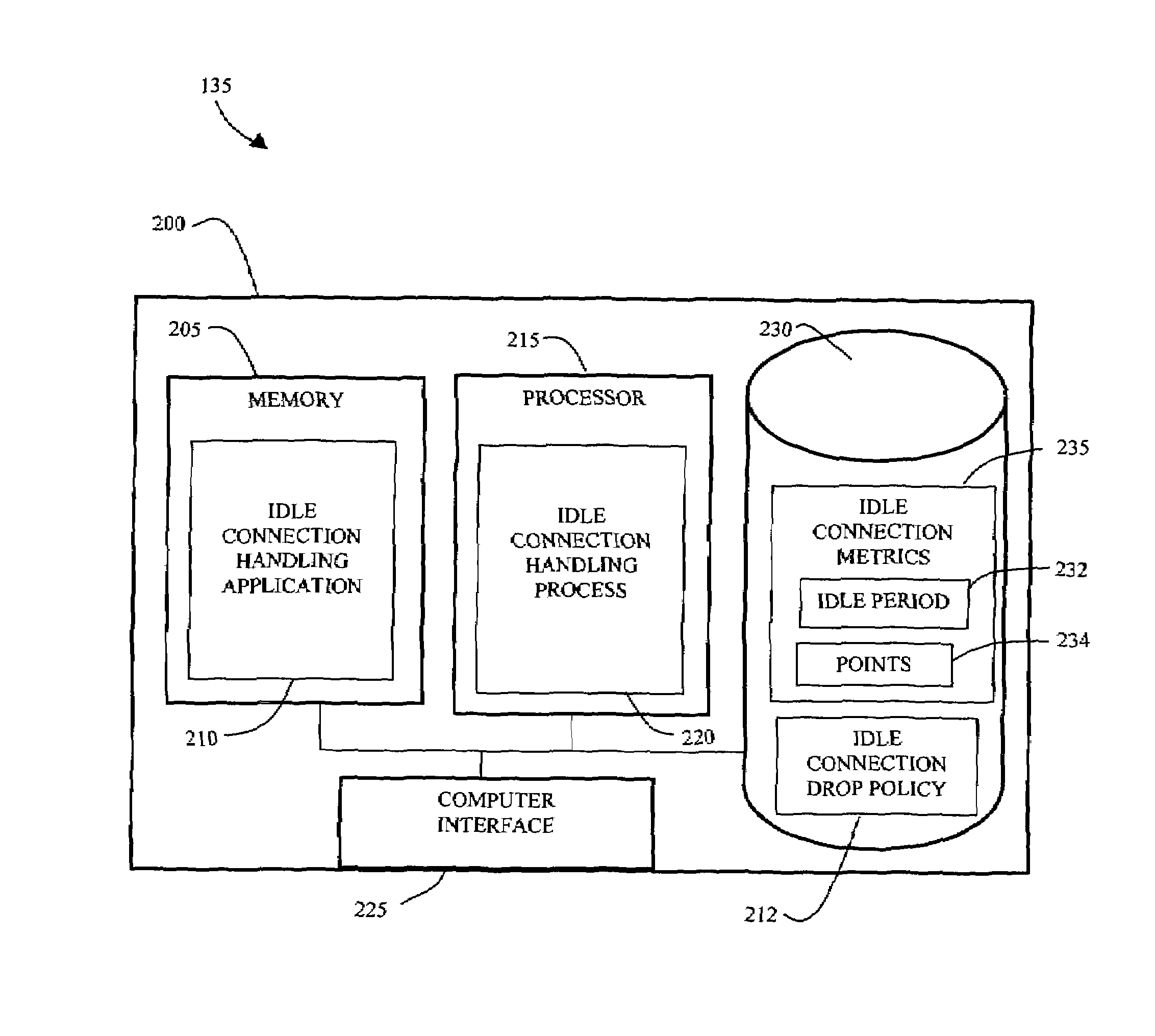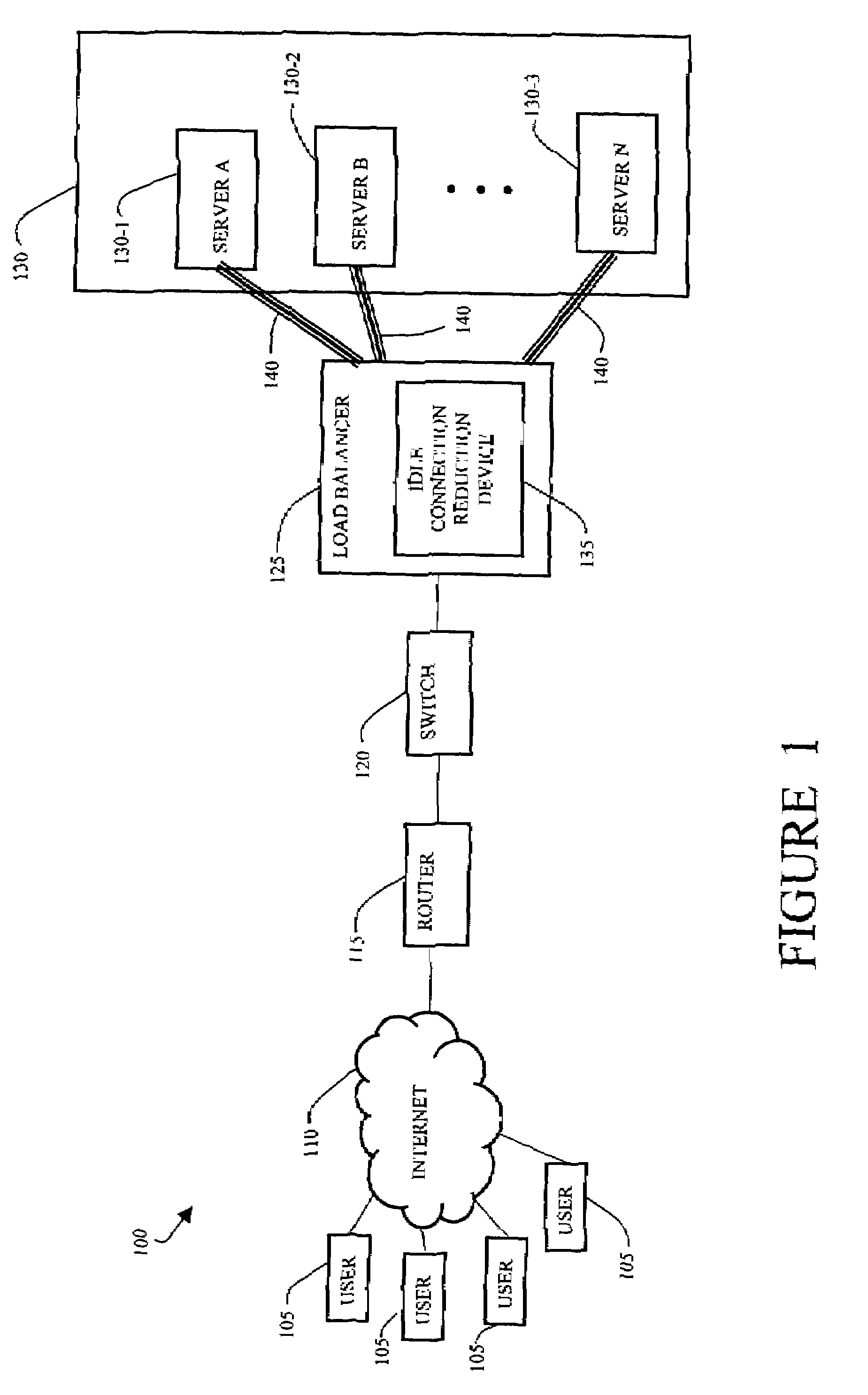[0012]The second conventional system discussed above in which existing connections are reused where possible, also does not fulfill the goal of managing idle connections to improve server utilization. Rather, the second conventional system conserves the number of overall connections created. If, however, back side connections are not closed, the system has a potential of entering a state where all the back side connections are idle and establishment of new connections is substantially delayed. Also, the second conventional system defeats a
Transmission Control Protocol (TCP) slow-start mechanism. The TCP slow-start mechanism is used to prevent
network congestion. When a client is newly connected to a server, the TCP process implementing the slow-start mechanism maintains data transfer at a
slow speed in order to avoid overwhelming a client having
limited resources such as a slow
network connection. As time passes, the TCP process in the server notes the capabilities of the client and increases speed of data transfer over the connection generally until the TCP process finds a limit of client capability. That is, data is delivered at an increasingly faster rate over the connection to that client until packets begin to be dropped. In the second conventional system, the established back side server connections may already be in
fast mode if, for example, the connections have been used to connect to fast clients. The second conventional system does not notify the back side server connections that a different client is attached at the front. The second conventional system does not slow down the existing connection for a new client. If a slow client is connected to (i.e., reuses) a fast connection, the slow client may receive data at an overwhelming speed and be unable to handle all packets. In addition, reusing back side connections for different clients confuses log file data. Log files regarding transactions between clients and servers over particular connections in the second conventional system would have transactions that are not actually related. This means that assumptions that may generally be made in server
software about communication to a same client in order to improve efficiency of communication are not necessarily valid.
[0013]It remains desirable to have a method and apparatus capable of taking
advantage of persistent connections to maintain efficient server utilization while avoiding the disadvantages of persistent connections found in conventional systems. In particular, it remains desirable to have a system and method for
selective reduction of idle connections so that the existing
pool of connections does not
delay incoming connections. Embodiments of the present invention significantly overcome the deficiencies described above and provide methods and apparatus for selectively reducing idle connections to improve computerized device utilization.
[0014]In the present invention, an idle connection reduction device selectively reduces the number of idle connections in a computerized device handling connections in a network. The computerized device, for example, could be a server, a load balancer, a
router or a switch. In operation, the idle connection reduction device monitors the connections in the computerized device and maintains idle connection
metrics for the connections. An example of an idle connection metric is an idle
timer for each connection. When the idle connection reduction device detects a condition indicating that idle connections should be dropped, the idle connection reduction device selectively drops connections from the set of connections according to an idle connection drop policy based on the idle connection
metrics.
[0015]More specifically, embodiments of the invention provide methods and apparatus for improving the efficiency of at least one server. One such method embodiment is implemented in a computerized device and comprises the step of monitoring a set of connections coupled to at least one server for idle connections. The method then includes the step of maintaining an idle connection metric for each idle connection in the set of connections. The method then continues with the step of detecting an idle drop condition to drop idle connections from the set of connections. The method then, in response to detecting the idle drop condition, further includes the step of performing a connection drop sequence according to a connection drop policy based on the idle connection metric for each idle connection. Therefore, the computerized device, by applying the connection drop policy to the idle connections as a set is able to selectively drop idle connections in order to maintain valued idle connections and drop less-valued idle connections to enable new connections and maintain server efficiency.
[0019]In a still further alternative embodiment of the invention, the step of detecting an idle drop condition involves maintaining a ratio of idle connections to active connections followed by the step of detecting whether the ratio exceeds a predetermined ratio threshold. Alternatively, the step of detecting an idle drop condition involves determining whether the idle to active ratio exceeds a maximum idle connection threshold. In one arrangement of the invention, the maximum idle connection threshold is based on a maximum number of connections possible in the at least one server. These embodiments of the invention detect an accumulation of idle connections at the at least one server and operate to reduce number of idle connections when the accumulation becomes too large.
[0021]In one embodiment of the invention, the step of performing a connection drop sequence involves dropping at least one idle connection having a longest idle period. In another embodiment of the invention, the step of performing a connection drop sequence involves dropping at least one idle connection based on that idle connection's assigned number of points. The idle connection is dropped, in one arrangement, when the assigned points exceed a predetermined point threshold. In another embodiment of the invention, the step of performing a connection drop sequence involves adjusting a connection
timer associated with the at least one idle connection so that the at least one idle connection is dropped more quickly when it becomes idle. Alternatively, the step of performing a connection drop sequence involves incrementing connection timers for new connections. Further alternatively, the step of performing a connection drop sequence involves incrementing connection timers associated with the connections proportionally to the rate of new connection attempts. The various connection drop sequences selectively reduce the number of idle connections by dropping connections according to the idle connection metric associated with the idle connections.
 Login to View More
Login to View More  Login to View More
Login to View More 


